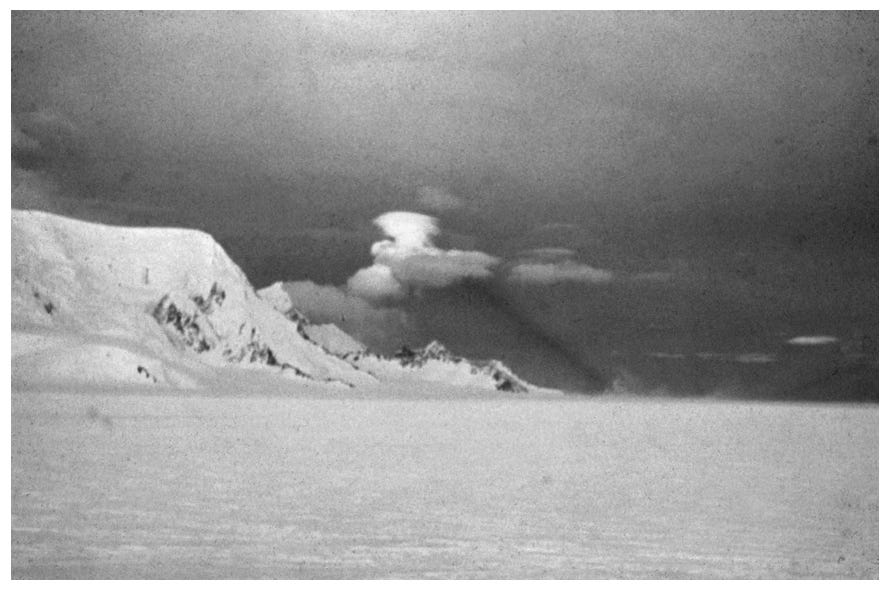An Antarctic Oddity
“There are more things in heaven…”
On May 22, 1966 two members of the British Antarctic Survey witnessed an unusual phenomenon while on Adelaide Island. One of them was Mr. Eric Wilkinson, a professional meteorologist and an excellent photographer. Published in the Journal of Transient Aerial Phenomena, Vol. 2, No. 1, May 1981, the following includes one of the photographs he made and his report:
As a scientist I am trained not to accept what can't be proven; as an artist I am trained to see more than is there at first sight; and as a Christian I believe that there are more things in heaven and earth than man can ever dream of. However, a balanced view of the Universe is necessary and to see it one must wear several hats. As senior meteorologist with the British Antarctic Survey from 1965 to 1968 it was my pleasure to see, as a scientist, artist and Christian, a continent so vast and full of strange phenomena, beauty and presence as to enrich my life very much indeed. I cannot prove that UFOs exist or do not exist and so I keep an open mind on most things. So it is with no answers that I lay before you a puzzle and hope that you can give me some answers. To me it is a “unique meteorological phenomenon”, but to the knowledgeable trained observer it may be something else.
Early on the morning of 22nd May, 1966, I emerged from a tent on the call of Sgt. Major George Green of R.E.M.E. and late of the Uganda Rifles. The dogs had picked up something and were causing a commotion. We observed a small dense cloud to the south at about five miles, near to Mount Gaudrey above the Fuchs Ice Piedmont, Adelaide Island, Lat. 68° South. The white cloud was like a rough pile of plates and was rising vertically at about 10' per second. It began at about 10° -15° from the ice and seemed to rise up internally as a pillar with successive broke hoops of cloud. Its altitude was about 500′ to 800′ and its size 100′ x 100′. The cloud was alternately expanding and contracting. A low buzzing sound like bees was perceptible. The cloud was visible for about 15 minutes before dissolving, although I cannot remember how it dissolved. At one point during the sighting, the cloud emitted a thick black ray of light which hit the ice at an angle of 45° and churned up a “snow devil”. ( “Snow devil” is a cloud of disturbed ice crystals rising from the point of impact.) A second ray was visible from the point of impact at about 110° to the first ray and seemed to be reflected upwards at about 30° to horizontal. The light conditions were dull daylight, no sun; weather conditions were moderate, definitely not thundery as this phenomenon is not witnessed often in Antarctica, if ever. There was about 5kts of wind.
At the time, I rushed my camera into action and took several slides at 100th of a second at f/11on Kodachrome II 25 ASA film. (See centre pages.)
The phenomenon was not bright although I feel that one part of the cloud was reflecting a yellowish colour.
Since the sighting I have been puzzled as to what kind of a phenomenon it was. I reported it in my meteorological report but no logical explanation was forthcoming. I personally doubt that it was anything more than a unique meteorological phenomenon but am open to any offers. The noise reminded me of an electrical storm I experienced at 15,000' on the Dom in Switzerland, as static electricity ran up and down my rope. I have also witnessed orographic clouds piled up like plates but not so low, away from the mountains and so small in stature. You can see from the photograph that it existed, but as to its origin or what it was, it is anyone’s educated guess at the moment. I have an open mind still puzzling after 10 years.
Eric Wilkinson
Belfast
N. Ireland
Ufologist Martin Shough examined Mr. Wilkinson’s report. Click the following title to read a PDF version of his analysis, “A Study of the Mysterious Black Ray of Antarctica.” Spoiler alert: Mr. Shough makes an excellent case for a natural cause, possibly anticrepuscular light, but acknowledges there may be other and more exotic explanations.



